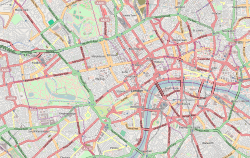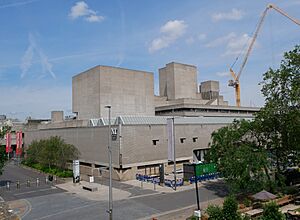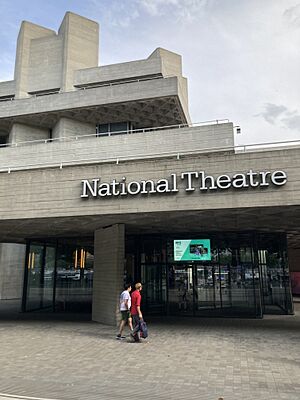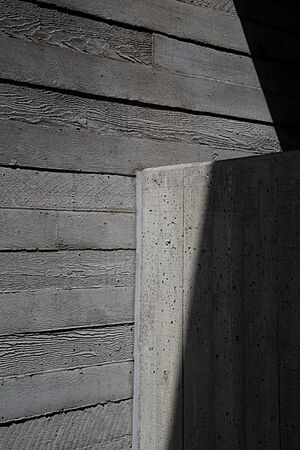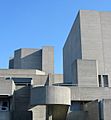Royal National Theatre facts for kids
|
National Theatre
|
|
 |
|

The National Theatre from Waterloo Bridge
|
|
| Former names | National Theatre Company (while based at the Old Vic from 1963) |
|---|---|
| Address | Upper Ground, South Bank London England |
| Coordinates | 51°30′26″N 0°06′51″W / 51.5071°N 0.1141°W |
| Public transit |
|
| Designation | Grade II* |
| Type | National theatre |
| Capacity |
|
| Construction | |
| Opened | 1976 (building) |
| Architect |
|
The National Theatre (NT), also known as the Royal National Theatre, is a famous place in London, England, where plays and shows are performed. It was started by Laurence Olivier in 1963. Many well-known actors have performed there over the years.
The theatre company first performed at The Old Vic theatre in Waterloo until 1976. The current building is located next to the River Thames in the South Bank area of central London. The National Theatre also sends its shows on tour to other theatres across the United Kingdom. Some productions have even traveled to places like Broadway in New York, China, Australia, and New Zealand.
In June 2009, the theatre started National Theatre Live (NT Live). This program broadcasts live performances to cinemas, first in the UK and then around the world. The first show broadcast was Phèdre, starring Helen Mirren. It was shown live in 70 cinemas across the UK. Since then, NT Live shows have been broadcast to over 2,500 places in 60 countries. In November 2020, the National Theatre also launched "National Theatre at Home." This is a streaming service where you can watch recordings of plays online.
Contents
How the National Theatre Began
For a long time, people in Britain wanted a special theatre to celebrate serious plays. In 1847, a writer named Dramaticus wrote about how British theatre needed to improve. At that time, many plays were simple melodramas or musical comedies. Critics wanted a place for more serious drama, especially to honor William Shakespeare.
In 1879, the famous French theatre company, the Comédie-Française, performed in London. This made people want a national theatre even more. They wanted a building in London to remember Shakespeare, a top-quality theatre company, and a place to help spread the love of great drama through education.
The Shakespeare Memorial Theatre opened in Stratford upon Avon in 1879. Later, in 1904, Herbert Beerbohm Tree started an acting school. But London still didn't have its own national theatre. In 1910, George Bernard Shaw even wrote a play called The Dark Lady of the Sonnets. In this play, Shakespeare himself tries to convince Queen Elizabeth I that a national theatre is needed for his plays.
Finally, in 1948, the London County Council offered a place near the Royal Festival Hall for the theatre. So, in 1949, the government passed the National Theatre Act 1949, which offered money to help build it.
Ten years later, in 1961, the government said they couldn't afford the theatre. But the London County Council offered to let them use the land for free and pay half the building costs.
In July 1962, agreements were made, and a group was set up to build the theatre. Another group was formed to run the National Theatre Company. This company started performing at the Old Vic theatre in the meantime. The National Theatre Company officially opened on October 22, 1963, with the play Hamlet. Laurence Olivier became the first artistic director of the company.
The permanent theatre building was designed by architects Sir Denys Lasdun and Peter Softley. It has three stages, which opened one by one between 1976 and 1977. The company stayed at the Old Vic until 1976, when the main stage, the Olivier, was ready.
Theatre Building and Design
The National Theatre building has three main theatres inside. There was also a temporary theatre from 2013 to 2016.
Olivier Theatre: The Main Stage
This theatre is named after Laurence Olivier, the first artistic director. It is the main auditorium and can seat 1,160 people. Its design is inspired by ancient Greek theatres, with an open stage and seats arranged in a fan shape. It has a special "drum revolve" stage that can turn and move scenery quickly. This design helps ensure that everyone in the audience has a good view.
Lyttelton Theatre: A Traditional Stage
Named after Oliver Lyttelton, the first chairman of the National Theatre's board, this theatre seats 890 people. It has a traditional proscenium arch stage, which is like a picture frame around the stage. The width of this arch can be changed.
Dorfman Theatre: A Flexible Space
The Dorfman Theatre is named after Lloyd Dorfman, a supporter of the theatre. It is the smallest and most flexible of the three theatres, holding 400 people. It used to be called the Cottesloe Theatre. This theatre can be set up in many different ways, like a traditional stage, a stage surrounded by the audience, or even a promenade style where the audience moves around. The Dorfman Theatre closed for renovations in 2013 and reopened in 2014 as part of the "NT Future" project.
Building Style and Views
The National Theatre building has a unique style, often called "Brutalist" architecture. This means it uses a lot of raw concrete. When it first opened, people had mixed feelings about its look. Some loved it, while others, like the future Charles III, joked about it looking like a power station.
Despite some debate, the theatre has been a Grade II* listed building since 1994. This means it's considered a very important historical building. Many now see its design as clever and well-balanced. A new lighting system at night makes the building look very impressive.
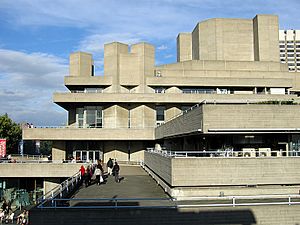
Inside the Theatre
The National Theatre's public areas are open to everyone. They include a large theatre bookshop, restaurants, bars, and spaces for exhibitions. The outdoor areas by the river are also used for free open-air performances in the summer.
The Clore Learning Centre is a special place for learning about theatre. It offers workshops and courses for all ages, teaching everything from writing plays to technical skills.
Actors' dressing rooms are arranged around a central open space. This means their windows face each other. Because of this, on the opening and closing nights of a play, actors have a tradition of drumming on their windows to wish each other luck.
You can also take tours backstage to see how sets are built, painted, and how props are made.
National Theatre Live: Bringing Theatre to You
National Theatre Live is a program that broadcasts live performances from the National Theatre (and other theatres) to cinemas and arts centers around the world. It started in June 2009 with a play starring Helen Mirren.
This program allows people who can't visit London to experience the theatre. The performances are filmed with special cameras, giving viewers a great experience.
Learning and Community Programs
The National Theatre offers many programs to help people learn about and get involved in theatre.
National Theatre Connections
This is an annual festival for youth theatre groups across the UK. Young people perform new plays written by leading playwrights. Some of these groups are invited to perform their plays at the National Theatre itself.
National Theatre Collection
The National Theatre Collection is a free streaming service for schools and colleges worldwide. It provides high-definition recordings of plays that are linked to school subjects. This service helps teachers and students use theatre in their learning. It includes popular productions like Frankenstein and Othello.
Public Acts: Community Theatre
Public Acts is a program that works with communities across the UK to create large-scale theatre shows. It brings together professional actors and people from local communities to perform together. The first Public Acts show was Pericles in 2018.
Outdoor Festivals
River Stage
River Stage is a free outdoor summer festival held outside the National Theatre. It takes place over five weekends and features performances from various theatre and dance companies. It also has food stalls and bars, making it a fun summer event.
Artistic Directors
The artistic director is the main person in charge of the plays and shows at the theatre. Here are the people who have held this important role:
- Sir Laurence Olivier (1963–1973)
- Sir Peter Hall (1973–1988)
- Sir Richard Eyre (1988–1997)
- Sir Trevor Nunn (1997–2003)
- Sir Nicholas Hytner (2003–2015)
- Sir Rufus Norris (2015–2025)
- Indhu Rubasingham (2025 - present)
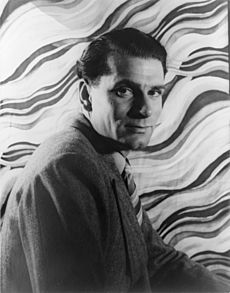
Laurence Olivier was a very famous British actor and the first artistic director of the National Theatre. He helped create the company and directed many successful plays.
Peter Hall took over and managed the move to the new building on the South Bank. He had also created the Royal Shakespeare Company.
Richard Eyre was an associate director before becoming artistic director. He was known for working with writer David Hare on plays about modern Britain.
Trevor Nunn came from the Royal Shakespeare Company and brought a more popular style to the National Theatre, directing famous musicals like Oklahoma!.
Nicholas Hytner became artistic director in 2003. He started the NT Live program and the Entry Pass scheme, which allowed young people under 26 to buy tickets for a low price.
Rufus Norris became artistic director in 2015. He was the first director since Laurence Olivier who did not graduate from University of Cambridge. He will step down in 2025.
Indhu Rubasingham was announced in December 2023 to take over as artistic director in 2025.

Famous Productions
The National Theatre has staged many memorable plays throughout its history. Here are some of them:
Plays from 1963–1973 (Laurence Olivier)
- Hamlet, starring Peter O'Toole (1963)
- Othello, with Laurence Olivier as Othello (1964)
- The Royal Hunt of the Sun by Peter Shaffer, the National's first world premiere (1964)
- Rosencrantz and Guildenstern Are Dead by Tom Stoppard (1967)
- The Merchant of Venice, with Laurence Olivier as Shylock (1970)
- Hedda Gabler by Henrik Ibsen, directed by Ingmar Bergman (1970)
Plays from 1974–1987 (Peter Hall)
- No Man's Land by Harold Pinter, starring Ralph Richardson and John Gielgud (1975)
- Bedroom Farce by Alan Ayckbourn (1977)
- Amadeus by Peter Shaffer (1979–80)
- Guys and Dolls, the National's first musical (1982)
- Glengarry Glen Ross by David Mamet (1983)
- Pravda by Howard Brenton and David Hare, starring Anthony Hopkins (1985)
Plays from 1988–1997 (Richard Eyre)
- Cat on a Hot Tin Roof (1988)
- Richard III starring Ian McKellen (1990)
- The Madness of George III by Alan Bennett, starring Nigel Hawthorne (1991)
- An Inspector Calls by J. B. Priestley (1992)
- Arcadia by Tom Stoppard (1993)
- A Little Night Music by Stephen Sondheim, starring Judi Dench (1995)
Plays from 1998–2002 (Trevor Nunn)
- Copenhagen by Michael Frayn (1998)
- Oklahoma! by Richard Rodgers and Oscar Hammerstein, starring Hugh Jackman (1998)
- Blue/Orange by Joe Penhall (2000)
- South Pacific by Richard Rodgers and Oscar Hammerstein (2001)
Plays from 2003–2014 (Nicholas Hytner)
- Jerry Springer: The Opera, a musical (2003)
- The History Boys by Alan Bennett (2004)
- War Horse (2007–2009)
- Phèdre featuring Helen Mirren (2009)
- Frankenstein, directed by Danny Boyle and starring Benedict Cumberbatch and Jonny Lee Miller (2011)
- One Man, Two Guvnors, starring James Corden (2011)
- The Curious Incident of the Dog in the Night-Time (2012)
- Othello by William Shakespeare starring Adrian Lester and Rory Kinnear (2013)
Plays from 2015–2025 (Rufus Norris)
- Everyman starring Chiwetel Ejiofor (2015)
- Angels in America starring Andrew Garfield and Nathan Lane (2017)
- Follies, a musical by Stephen Sondheim (2017)
- Network, starring Bryan Cranston (2017)
- The Lehman Trilogy (2018)
- Antony and Cleopatra by William Shakespeare, starring Ralph Fiennes and Sophie Okonedo (2018)
- Hadestown, a musical (2018)
- The Ocean at the End of the Lane by Neil Gaiman (2019)
- The Crucible by Arthur Miller (2022)
- Standing at the Sky's Edge (2023)
- Dear England by James Graham (2023)
- The Witches by Roald Dahl (2023)
- Nye starring Michael Sheen (2024)
- The Importance of Being Earnest by Oscar Wilde (2024)
Plays from 2025–present (Indhu Rubasingham)
- Bacchae (2025)
- The Playboy of the Western World (2025)
- Les Liasons Dangereuses, starring Lesley Manville (2026)
Royal Patrons
The National Theatre has had support from the Royal Family:
- Queen Elizabeth II (1974–2019)
- Meghan, Duchess of Sussex (January 2019–February 2021)
- Queen Camilla (March 2022–present)
Images for kids
See also
 In Spanish: National Theatre para niños
In Spanish: National Theatre para niños
- National Youth Theatre
- National Theatre of Scotland
- National Theatre of Wales
- Wales Millennium Centre
- National Theatre of Ireland
- List of Royal National Theatre Company actors


